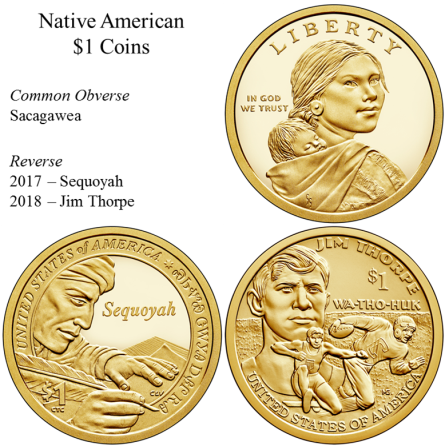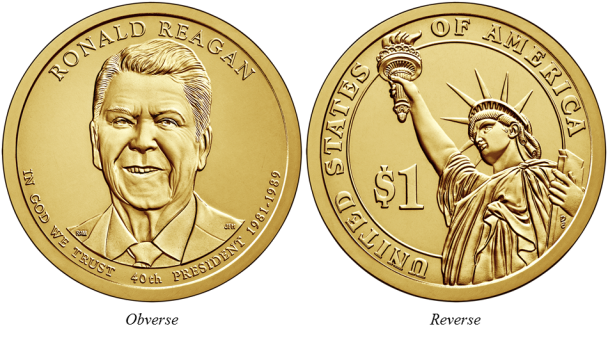On June 20, 2018, the Senate passed an amended version of H.R. 770, the "American Innovation $1 Coin Act." This bill would require the Secretary of the Treasury to mint new $1 coins "in recognition of American innovation and significant innovation and pioneering efforts of individuals or groups from each of the 50 States, the District of Columbia, and the United States territories." The proposed Innovation $1 coins would be minted beginning in 2019. The Senate's action follows House passage of its version of H.R. 770 on January 16, 2018.
Congressional Involvement in Coin Design
The creation and circulation of money in the United States involves several agencies. The Federal Reserve Board has the authority to issue paper currency, which it orders from the Department of the Treasury's Bureau of Engraving and Printing. Coins are minted and issued by the U.S. Mint (although the Federal Reserve influences the amounts by providing the Mint with monthly orders and forecasts). In addition, the designs of coins are prescribed by Congress, and an act of Congress is required to change the design of coins.
Since the enactment of the Coinage Act of 1792 (1 Stat. 246), which established the U.S. Mint and prescribed various aspects of U.S. coinage, Congress has been involved in the design of circulating coins. For example, the Coinage Act directed the U.S. Mint to strike coins of specific denominations—Eagles ($10), Half Eagles ($5), Quarter Eagles ($2.5), dollars ($1), half dollars ($0.50), quarter dollars ($0.25), dimes ($0.10), half dimes ($0.05), cents ($0.01), and half cents ($0.005)—with specific images and words, including images of eagles and the words "United States of America." Additionally, recent laws have prescribed certain images—such as which Presidents appear on the obverse of which coins and what images are to appear on the coins' reverse—through law.
Should Congress wish to create a new coin program, or dictate a design change for current coins, an act of Congress is required. Should an act to redesign the $1 coin become law, the Secretary of the Treasury would incorporate the specified design preferences to reflect congressional direction.
For more information, see CRS In Focus IF10533, Congressional Involvement in the Design of Circulating Coins, by [author name scrubbed].
Current Status of the $1 Coin
In recent years, the U.S. Mint has produced $1 coins as a part of two different programs: Native American $1coins and presidential $1 coins.
Native American $1 Coins
American $1 coins currently honor Native Americans and the important contributions made by Indian Tribes and individuals in U.S. history (31 U.S.C. §5112(r)). By law, these coins were issued beginning in 2008 and feature Sacagawea on the obverse and a design that "bear[s] images celebrating the important contributions made by Indian Tribes and individual Native Americans to the development of the United States and the history of the United States" (31 U.S.C. §5112(r)(2)) on the reverse. Figure 1 shows the 2017 and 2018 Native American $1 coins.
Presidential $1 Coins
Between 2007 and 2016, the U.S. Mint also issued $1 coins to honor each former President of the United States. Authorized by P.L. 109-145, the Presidential $1 Coins began with George Washington and concluded with Ronald Reagan in 2016. The law further provided that "no coin issued under this [law] may bear the image of a living former or current President, or of any deceased former President during the 2-year period following the date of the death of that President" (31 U.S.C. §5112(n)(2)(E)). Figure 2 shows the Ronald Reagan Presidential $1 Coin, the last issued by the U.S. Mint. The presidential $1 coins featured the likeness of the President on the obverse and the Statue of Liberty on the reverse.
Current $1 Coin Legislation
Should H.R. 770, the "American Innovation $1 Coin Act," become law, new $1 coins would be minted beginning in 2019. The bill, as passed by the House and Senate, would require that the U.S. Mint produce four coins per year for 14 years. This would include one coin per state, the District of Columbia, and the U.S. territories (the Commonwealth of Puerto Rico, Guam, American Samoa, the U.S. Virgin Islands, and the Commonwealth of the Northern Mariana Islands). Under the House version of H.R. 770, the coins would be issued in alphabetical order, beginning with Alabama. The Senate version includes an amendment that would require the coins be issued in the order in which the states ratified the Constitution, with coins for the District of Columbia and the U.S. territories issued after the last of the states in a prescribed order (District of Columbia, Commonwealth of Puerto Rico, Guam, American Samoa, the U.S. Virgin Islands, and the Commonwealth of the Northern Mariana Islands). The issuance of the American Innovation $1 coins would not affect the continued issuance of the Native American $1 coins.
H.R. 770 specifies several features of the potential coins
- the obverse should contain an image of the Statue of Liberty;
- the reverse image should include "(i) An image or images emblematic of one of the following from one of the 50 States, the District of Columbia, or the territories of the United States": These images could include a significant innovation, an innovator, a group of innovators, the name of the state, the District of Columbia, or territory, as applicable, and the inscription "United States of America"; and
- the coins' designs would be selected by the Secretary of the Treasury in consultation with the governor or chief executive of each state, the District of Columbia, or territory and the U.S. Commission of Fine Arts. The designs would also be reviewed by the Citizens Coinage Advisory Committee.
In addition to H.R. 770, two bills have been introduced in the Senate to authorize the American Innovation $1 coin: S. 1326 and S. 2399.

